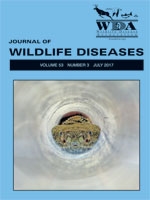Since 2006, bat populations in North America have suffered devastating mortality from an emerging disease known as white-nose syndrome (WNS). The causal agent of WNS is the fungus Pseudogymnoascus destructans. In April 2014, WNS was discovered in little brown bats (Myotis lucifugus) in Michigan, US, and has since been documented in 12 counties. Because current surveillance for WNS focuses primarily on mine-hibernating species in winter, it is subject to geographic, species, and seasonal bias. To investigate species affected and potential associations of gender, seasonal life cycle, and region with P. destructans prevalence, 1,040 rabies-negative bats were sampled from May 2014 to May 2015 from animals submitted as part of statewide rabies surveillance. The vast majority (96%) of the sample population consisted of big brown bats (Eptesicus fuscus), a noncavernicolous species. Two methods were used to detect P. destructans: fluorescence of the muzzle, wing, and tail membranes under ultraviolet light and PCR targeting genomic DNA on wing samples. Only five bats (0.5%), all M. lucifugus, were confirmed positive after nucleic acid sequencing of PCR amplicons. No other species were infected. All infected bats were collected from April to May, coinciding with their emergence from hibernation. As P. destructans and WNS spread westward, novel surveillance streams may provide a useful tool for wildlife management agencies seeking to detect the fungus where winter hibernacula such as caves and mines are absent or otherwise inaccessible.
How to translate text using browser tools
1 July 2017
PREVALENCE AND DISTRIBUTION OF PSEUDOGYMNOASCUS DESTRUCTANS IN MICHIGAN BATS SUBMITTED FOR RABIES SURVEILLANCE
Samantha L. Darling,
Ailam Lim,
Julie R. Melotti,
Daniel J. O'Brien,
Steven R. Bolin
ACCESS THE FULL ARTICLE

Journal of Wildlife Diseases
Vol. 53 • No. 3
July 2017
Vol. 53 • No. 3
July 2017
Big Brown Bat
Eptesicus fuscus
Little Brown Bat
Myotis lucifugus
Pseudogymnoascus destructans
surveillance systems
white-nose syndrome




